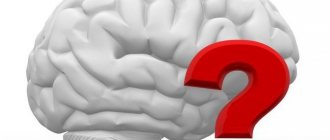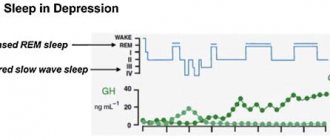Healthy sleep is one of the main factors in a person’s well-being. It is not always possible to get enough sleep or sleep the required 8 hours every day. Of course, there are also stresses, failures at work, and the brain scrolls through depressing thoughts half the night. But what to do when you manage to fall asleep without problems, but are tormented by nightmares or such a phenomenon as sleep paralysis? In this state, you cannot move, you cannot shout, or say anything, and all this is accompanied by seemingly mystical visions. This is really alarming and frightening for any person, especially a child who has encountered such burning in his life for the first time. In this article we will talk about sleep paralysis (awakening cataclepsy), how terrible it is, and how it affects the general condition of a person.
Awakening cataclepsy can occur not only for physiological, but also for psychological reasons
What is sleep paralysis
First you need to understand what sleep paralysis actually is. Sleep paralysis is a condition in which temporary stupor appears while the brain is already in the active phase and the body is completely or partially paralyzed. This condition appears during falling asleep (the moment of falling asleep) or awakening. Sleep paralysis is also called sleep stupor or awakening cataplexy.
Such conditions are studied by the branch of medicine – somnology. Somnologists generally believe that sleep paralysis occurs when dreaming and waking occur. Sleep paralysis usually occurs upon awakening (coming out of the sleep phase), when the dreaming stage ends, or before falling asleep. However, cases of sleep paralysis before falling asleep are much less common. The dreaming stage is called the REM stage of sleep, during which all a person’s muscles completely relax, and in sleep paralysis, this relaxation is maintained while the brain is active.
There are currently no accurate statistics on sleep paralysis. This may mean that actual cases of paralysis are much higher than the officially reported 5-8%. If you ask your friends if they have ever dreamed of sleep paralysis, explaining its symptoms, you will probably meet a couple of acquaintances who have experienced this phenomenon.
What does it look like
For understanding, I will give an example: a person realizes that he has woken up, his thoughts and consciousness are clear, however, if he wants to turn over, the body does not obey, and the muscles seem to be paralyzed. The person lies motionless, unable to speak or call for help. Moreover, often with sleep paralysis, a person begins to notice dark figures that stand next to the bed or sit nearby, sometimes it feels as if they are sitting right on the chest. At the same time, the heart begins to beat quickly, the person may choke and hear strange sounds and buzzing. Directly in this state, when you wake up, you experience anxiety or an attack of anxiety (fear, rapid heartbeat, anticipation or feeling of something bad, etc.). This state lasts from 10 seconds to 2 minutes, after which the ability to move again appears, the heart rate is restored and the condition returns to normal.
Many people confuse what they see during sleep paralysis with mysticism and paranormal phenomena.
What causes sleep paralysis
In most cases, sleep paralysis occurs when a person is lying on their back while sleeping. The state of sleep paralysis is provoked in all people by various pathologies and conditions of the nervous system, as well as a number of other reasons. The causes of sleep paralysis include severe stress, stimulation of the nervous system, disruption of the biological clock, mental disorders, and others. Experts include factors that provoke sleep paralysis:
Depressive conditions of any nature and severity
Arterial hypertension, hypertension (high blood pressure)
Increased physical activity
Post-traumatic stress disorder
Neurodegenerative diseases (Parkinson's disease, Alzheimer's disease, dementia and the like)
Diseases of the nervous system (narcolepsy or other disorders associated with sleep pathology)
Migraine, frequent headaches, epilepsy
Use of pharmacological drugs, toxic effects on the nervous system (substance abuse, drug or alcohol addiction, taking tranquilizers or antidepressants)
Emotional or physical overload when the brain does not rest
Somnambulism (sleep disorders in which a person performs certain actions while asleep)
Anxiety and anxiety disorders
Mental illnesses, disorders. These include bipolar disorders, schizophrenia and other diseases that are characterized by sleep disorders, nervous system disorders, and neuronal oscillations.
Fears, traumas, which are also accompanied by nightmares
Is sleep paralysis dangerous?
Sleep paralysis has been known to mankind since ancient times; it is also called old witch syndrome. Its appearance was associated with the action of black magic, evil spirits, demons and other evil spirits. About 40% of people have experienced it at least once. And in most cases it does not affect the general health of a person.
That is why it does not pose any particular danger to humans, although anxiety and emotional shock after what they saw can affect the human psyche.
A person’s fragile psyche can lead to the fact that upon waking up, a person is convinced to experience a paranormal presence
The Woman in Black and Daniel Radcliffe
0
Source:
Another observation made by scientists confirms that sleep paralysis depends on the position in which you sleep. Most often, its victims sleep on their backs, as in this case. “I woke up with a heavy weight pressing on my chest. Out of the corner of my eye I saw some creepy creature sitting on the edge of my bed. It looked like a woman wearing a large hat, with her face covered with a veil. Suddenly she started stomping her feet, demanding that I look at her immediately. Somehow I knew that if I looked at her, I would die. But in any case I could not do this: I lay on the bed, completely helpless, and could not move. I was lying on my back and my head was turned to the side. I remember that there was a nightstand in front of my eyes, and I tried to reach the glass standing on it to throw it at this terrible creature, but my hands did not move. When I woke up, I cried. It was the most terrible thing I have ever experienced in my life. To this day I can’t sleep on my back.”
What happens with sleep paralysis
As previously mentioned, sleep paralysis occurs before falling asleep or upon awakening. What happens with sleep paralysis?
Doctors explain the occurrence of paralysis as follows: in the REM sleep phase, the human body falls into numbness and becomes paralyzed. At this moment, consciousness, visual organs and organs whose work is necessary to maintain life remain active. In this state, the body is completely relaxed and ready for further rest and unloading of brain activity.
The state of sleep paralysis appears when there is a failure in the activity of brain mediators, which do not give a signal in time to turn on the muscles. This results in a temporary stupor, which explains the delay in the functioning of the muscles and brain. A person consciously feels that he has woken up, but the body and muscles at this moment do not yet obey him - the dream is mixed with reality.
People who have experienced paralysis have similar descriptions of what happened. Silhouettes, faces, distorted human bodies, hands, and distortion of reality may appear. At the same time, such visions are felt as absolutely real. Sometimes such sleep paralysis is accompanied by special sound deformations - clapping, steps, jumping and other temporary sounds that frighten the person waking up.
Characteristic manifestations
The main symptom of this condition is awareness of what is happening around, but lack of ability to speak or move. Moreover, this phenomenon is observed at the moment of awakening or when falling asleep.
When you experience Old Witch Syndrome, you may experience the following symptoms:
- eye mobility is preserved, for some at this moment they may even be open;
- feeling of tightness in the chest;
- labored breathing;
- feeling of horror;
- the appearance of visual or auditory hallucinations that are accompanied by an emitted threat or danger.
The Scientific Explanation of Sleep Paralysis
Thanks to scientific research, it has been noted that paralytic sleep can occur in more than 30% of a completely healthy population who do not have mental disorders. The first cases of paralysis occur on average in people aged 16–17 years. Women are slightly more likely to experience sleep paralysis - 19%, and less often among men - 15%. It is important to understand that such phenomena also occur in young children, but most often parents reduce what the child describes to childish impressionability and fantasy.
The mechanism of occurrence from a scientific point of view is explained by many scientific theories, which we will consider with you further.
- The first theory is based on heredity. In the process of mutation of the gene that is responsible for circadian rhythms (fluctuations in the biological processes of the human body associated with the transitions of day and night), changes occur in the advanced phase of sleep.
- Clusters of cells. Mediators located in the brain area accumulate in groups without forming a single center. Thus, some mediators work separately, which leads to disruption of the muscles and consciousness.
- Activation of brain neurons. This theory is based on the fact that nonspecific activation of neurons occurs in the brain, forming two centers that are responsible for the phases of sleep. Such nerve centers are located in the diencephalon and ensure the functioning of neurons with a significant delay from each other.
The peculiarity of the appearance of sleep paralysis while sleeping on the back is explained by scientists by the fact that in this position the blood drains from the frontal lobes of the brain - the person becomes prone to hallucinations. Oxygen starvation also provokes the occurrence of this condition. Hypoxia entails disruptions in blood circulation, respiratory processes, and the appearance of convulsive conditions.
People who have experienced sleep paralysis note that it most often occurs on the back
Precautionary measures
It is important to learn to cope with stress factors
- It is important that your night's sleep lasts at least eight hours. It is recommended to go to bed no later than 11:00 at night.
- You should try to follow a schedule of going to bed and waking up at a certain time, and not violate it.
- Make sure that your bedroom has a good atmosphere: a ventilated room, optimal air temperature and humidity.
- There is no need to consume caffeinated drinks or alcohol before going to bed. It is also important to remember that meals should be no later than three hours before bedtime.
- Try to keep electronic devices, especially your mobile phone, as far away from your bed as possible.
- It is important to remember the need for constant physical activity, which promotes the production of endorphins.
- Try not to lie on your back when going to bed.
- Protect yourself from stress factors.
Now you know what the phenomenon of sleep paralysis is. It is important to learn how to react correctly to this stupor. And, if this syndrome manifests itself more and more often, then it is worth taking action, contacting a somnologist or neurologist so that a specialist can prescribe adequate therapy.
Symptoms of sleep paralysis
The symptoms of sleep paralysis are different for everyone who experiences the condition. Experts divide the symptoms and signs of night paralysis into primary and secondary.
Primary symptoms include the following:
- Inability to move. Paralysis affects all major muscle groups and the person is unable to move.
- Inability to utter any words or even move your lips.
- Semi-conscious or conscious state. That is, during sleep paralysis, a person remains conscious and is able to remember the entire episode. Or, in the case of a semi-conscious state, he is partially aware of the reality of what is happening.
- Perception of the external world. Thus, a person in night paralysis fully perceives his environment, things, colors, materials, and so on.
Experts include secondary symptoms:
- Heavy, labored breathing. Difficulty breathing can be caused by the very position in which a person fell asleep, panic attacks, pressure in the chest/on the chest.
- Pressure in or on the chest. This symptom is associated with difficulty breathing. A person feels pressure on the chest, similar to a pile of something on top. Many people describe this condition as “like someone sitting on their chest.”
- Feeling of uncontrollable fear. An incomprehensible state, the inability to speak and move can cause anxiety and panic, which are accompanied by the body's natural reaction - fear.
- Feeling helpless. Most of those who have experienced sleep paralysis note that during the period of paralysis they experienced absolute helplessness. It is also associated with uncontrollable panic, fear and cessation of motor functions.
- Hallucinations. All cases of sleep paralysis are accompanied by various kinds of hallucinations. These hallucinations can affect the auditory, visual, and tactile senses. For example, with auditory hallucinations a person hears buzzing, crackling, rustling, and voices. With visual ones, they see objects, creatures, people that do not exist in reality. Some experience olfactory hallucinations of various kinds, often in the form of smells.
- Mystical and unusual sensations. Mysticism is explained by the fact that consciousness is confused with dreams; the human psyche “draws” images that usually correspond to the disorders and fears that a person experiences, for example, when under prolonged stress. Some cases are accompanied by sensations of mystical creatures, a feeling that a person is swimming or flying, soaring.
Symptoms of sleep paralysis are the same for all survivors
Types of sleep paralysis
During research into the phenomenon of sleep paralysis, scientists identified two main types, which we will consider later.
- The first type is semi-conscious (hypnagogic). Semi-conscious cases are those that occur when a person begins to fall asleep. An attack of paralysis begins at the junction of wakefulness and sleep.
- Hypnopompic. This type of sleep paralysis occurs upon awakening. A person wakes up, or rather those areas of the brain responsible for active activity, but consciousness itself has not yet returned to normal after the sleep phase. This condition occurs from a sudden awakening, such as noise.
Characteristics of the disease
Sleep paralysis is a pathology in which certain areas of the brain responsible for consciousness and motor activity of a person during certain periods of sleep, or after awakening, work with varying degrees of activity.
In this case, the following picture is observed when a person is already falling asleep, his muscles are relaxed, the body cannot fully move, but consciousness is still in an active state.
The same picture can be observed even after waking up: consciousness is already “on”, but the body is still asleep.
As a result of such inconsistency in the actions of parts of the brain, a person feels paralyzed; while conscious, he cannot move. This leads to the development of panic, fear for one’s own life.
Often the attacks are accompanied by hallucinations and other alarming symptoms.
The disease does not develop on its own; special predisposing factors are required for the appearance of characteristic signs. This:
- Presence of mental disorders.
- Frequent stress, overwork.
- Characteristics, expressed emotionality.
- Brain pathologies (traumatic or infectious lesions).
- Taking certain groups of medications, drugs, drinking alcohol.
- Hormonal imbalances.
- Violation of the daily routine (for example, when a person deliberately struggles with sleep, if he urgently needs to complete work or finish reading an interesting book), lack of proper rest (for example, when a person works for a long time on the night shift and does not have the opportunity to rest properly during the day).
Hallucinations during sleep paralysis
During research conducted in 1999, scientists identified three main types of hallucinations that occur during sleep paralysis: presence, incubus and vestibular-motor hallucinations.
Feeling of presence
This type of hallucination is expressed in sensations of the presence of people, creatures, animals. And also in auditory and visual hallucinations, which can be expressed in the sensation of whispers, steps, door slams, noise or voices and other various phenomena of a hallucinogenic nature.
Hallucinations of a sense of presence are born in the brain center - the amygdala, also called the “fear center”. The active activity of the amygdala is triggered by external stimuli, to which the fear center immediately sends a reaction in the form of fear to protect the body.
The entire amygdala complex in the brain structure includes the amygdala itself, the thalamus, which triggers the activity of the amygdala, the anterior cingulate cortex and intermediate links. Scientists have determined that when projections from the thalamus affect the fear center, the cerebral cortex and its other parts begin to activate a protective function, which causes obsessive hallucinations.
In situations with a real threat, areas of the brain begin to actively develop defensive reactions. Brain activity analyzes the external threat and, if it is not confirmed, the impulses weaken and the activity of the fear center decreases. With sleep paralysis, the analysis of brain activity reaches a dead end and is unable to find a threat. Thus, the fear center does not turn off, and the person experiences overwhelming fear, panic and anxiety during sleep paralysis.
The feeling of presence is the most terrible sensation during sleep paralysis
Incubus
The next type of hallucination has a mysterious name - incubus. In the Middle Ages, an incubus was a name given to a demon-tempter who appeared to young and innocent girls in search of debauchery. Many who have experienced sleep paralysis say they have seen a witch, devil or other demonic creatures sitting on their chest. This is what explains the pressure on the chest and the inability to breathe freely.
During the sleep phase, breathing accelerates and becomes more shallow in some areas. Sleep paralysis occurs precisely at a time when breathing remains shallow, blocking its further passage. When muscles are paralyzed, it is not possible to slow down accelerated breathing - muscular and respiratory resistance arises, which is felt as pressure on the chest.
Thus, stationary muscles send a signal to the brain centers responsible for reactions associated with struggle and survival functions. It is these centers that cause spasms and pain. A person feels that he really feels them, although the body itself remains fine and this is nothing more than a protective reaction of the brain.
With paralysis, you can not only see the entire creature or object, but also parts of the body, such as your hands. It may also seem to you that someone is breaking down a door or a wall - it all depends on the circumstances and the person’s very consciousness.
Vestibular-motor hallucinations
Hallucinations associated with vestibular-motor functions cause a person to experience flying, falling, floating or rising, in some cases floating above the bed. The vestibular system is located in the temporal, frontal and parietal lobes - it is responsible for coordinating all human movements and is close to the centers regulating circadian rhythms in the brain stem. When the vestibular system engages the brain stem, a person experiences movement, floating, and other unusual changes in motor activity.
The nature of the movements depends on which lobe is involved during sleep paralysis:
- The angular gyrus allows for the sensation of floating or the sensation of floating;
- The parietal lobe causes sensations of falling, sliding, or rising.
Another reason for changes in vestibular-motor functions is a weakening or decrease in blood flow to the brain and other lobes - as a result, disturbances in motor and tactile function occur and vestibular-motor hallucinations appear.
Sleep paralysis may cause sensations of levitation.
Is it possible to die during sleep paralysis?
Sleep paralysis has not been fully studied, and the nature of paralysis is still not clear to either scientists or other physicians. It is unknown whether sleep paralysis is a pathology or a minor deviation from the norm. However, psychologists recommend treating isolated cases as ordinary nightmares or a form of sleepwalking (somnambulism).
A large number of studies have not revealed a single case of death specifically due to sleep paralysis or during it, although if you experience such sensations too often, it makes sense to consult a neurologist and epileptologist.
A person is indeed capable of dying in his sleep, but, as a rule, this happens from a heart attack, stroke or other causes and disorders that lead to cardiac arrest. You also don’t have to worry about breathing problems, because when the level of oxygen in the blood drops, a person immediately wakes up.
Cases of death during sleep do occur, for example, with apnea syndrome, when breathing stops, however, death itself does not occur as a result of stopping breathing, but as a result of its effect on the cardiovascular system. Therefore, scientists answer the question “Is it possible to die during sleep paralysis” unequivocally no.
Causes
Understanding sleep paralysis for what it is, it can be argued that it is a sign of various neurological disorders. Experts associate it with the following pathologies:
- Narcolepsy, which causes a person to suddenly and unintentionally fall asleep.
- Somnambulism, which is characterized by sleepwalking.
- Bipolar disorder, in which manic activity abruptly turns into deep depression.
But still, more often than not, sleep paralysis, the causes of which are not fully understood, is associated with a spontaneous disturbance in the functioning of the nervous system. They can be triggered by various household factors. The imbalance occurs against the background:
- Disturbances in circadian biorhythms that occur when climate zones change.
- Hormonal imbalance.
- Harmful addictions.
- Uncontrolled use of antidepressants.
Sleep paralysis often occurs in stressful situations and during psycho-emotional overload. Sleeping on your back can cause it, although there is no medical explanation for this. A genetic predisposition has also been proven, since very often this condition is observed in members of the same family.
How to help yourself during an attack
The duration of sleep paralysis lasts several seconds or minutes. During this time, nothing terrible happens to the person, but the condition is not the most pleasant. In night paralysis, a person can become aware of what has happened to him if, for example, he is informed about the possibility of such a state or has already experienced it before. Unpleasant and even terrible sensations during paralysis do not please anyone and do not give much pleasure, therefore, to get out of this state on your own, you can take some actions:
- Realize that this state and everything that happens is just the influence of hallucinations. The resulting condition does not occur in reality, but is just a slight disruption of brain activity.
- Try to relax, relax all your muscles. Fear forces a person to tense the whole body more, which only worsens the convulsive and constrictive state.
- Try moving your muscles, such as moving your tongue, moving your lips, blinking, rolling your eyes, or using your fingers and toes.
- If the muscles still do not obey you, distract yourself from what is happening with brain activity in the form of counting, pronouncing words, letters, concepts or other systemic formations.
When recovering from sleep paralysis, it is important to try to gain some ability to move the body.
How to avoid sleep paralysis
This transitional state and changes in brain activity during sleep frighten many people, not only those who have already experienced it, but also those who have heard about the possibility of such a phenomenon. How to avoid sleep paralysis or prevent it, you should avoid the following factors that influence its manifestation:
- lack of sleep, insomnia, interrupted sleep;
- uncomfortable environment in the bedroom (this could be see-through curtains, stuffy room, noise and other factors);
- uncomfortable bed or incorrect sleeping position;
- lack of routine, incorrect daily routine;
- poor nutrition (lack of beneficial microelements and lack of vitamins);
- physical or emotional stress;
- alcohol, tobacco or drug addiction;
- taking medications (especially tranquilizers, antidepressants and other medications that affect the nervous system).
Somnologists advise avoiding severe stress, adhering to a healthy and correct lifestyle, then you can avoid not only sleep paralysis, but also many other disorders and diseases.
Treatment
Even if you do not consider night paralysis to be life-threatening, regularly recurring attacks must be dealt with.
This is a serious sleep disorder, due to which a person loses the ability to fully rest and restore the strength spent during the day. And if the problem is not solved for a long time, an unstable emotional state, increased anxiety and constant fatigue can result in severe depression or neurosis.
How can a doctor help in such a situation? First, he will conduct a high-quality diagnosis to figure out what factors provoke attacks at night. This requires consultation with a neurologist, somnologist, and sometimes a psychiatrist. To make a diagnosis, polysomnography is prescribed, which allows assessing a person’s brain and respiratory activity during sleep, EEG, respiratory monitoring, as well as, if necessary, a test for narcolepsy and a psychological examination. Based on the results obtained, the patient is selected an appropriate treatment option designed to return him to sound, healthy sleep.
Drug therapy
How to treat sleep paralysis with medications? First, understand the specifics of the problem: an imbalance between brain and muscle activity is not an independent disease, which means there are no special pills or drops to get rid of the old witch syndrome. However, traditional medicine is quite capable of influencing the factors that provoke attacks of sleep paralysis, which is why drugs are prescribed that improve the quality of night's rest.
In such cases, patients are advised to take:
- " Melaxen ". A product containing a synthetic analogue of melatonin to normalize the change in sleep and wakefulness cycles. It has practically no side effects or contraindications, is not addictive, and also has a positive effect on overall well-being, strengthens the immune system and stabilizes blood pressure.
- " Vita-melatonin ". Another sleep hormone substitute with a complex effect on the body. Activates the immune system, increases mental and physical performance and eliminates anxiety. The effect of taking Vita-melatonin comes quickly, but the drug has an impressive list of possible side effects, so it is not recommended to take it for a long time.
- " Neurostabil ". A plant-based dietary supplement with a general strengthening and sedative effect. It increases the body's resistance to stress, restores normal functioning of the nervous system, reduces blood pressure, and also has an anticonvulsant effect. The main advantage of the drug is its exclusively natural composition with minimal risk of side effects. Among the disadvantages: the result may not appear immediately, so you will have to take Neurostabil for at least a month.
Also an important component of drug treatment for attacks of paralysis during sleep is taking vitamins. The loss of a healthy night's rest and constant anxiety, noticeably intensifying in the evening, when you need to go to bed, undermine the body's strength, creating ideal conditions for the exacerbation of chronic diseases and the emergence of new diseases. This means that during this period a person especially needs vitamins A, C, D, E and group B, as well as magnesium and potassium.
Physiotherapy
How can you get rid of sleep paralysis using physiotherapeutic procedures? The main goal of treatment is to stabilize the patient’s nervous system, so physical therapy usually boils down to:
- massage to relieve tension, muscle and psycho-emotional, eliminate anxiety and activate blood circulation;
- acupuncture with its restorative effect on the body;
- electrophoresis, which enhances the effect of the administration of sedatives;
- aerotherapy, which helps relax the nervous system, saturate the blood with oxygen and maintain muscle tone;
- electrosleep to combat night paralysis through low-frequency electrical impulses delivered to the blood vessels and brain.
Relaxing baths with the addition of essential oils, herbal infusions, sea salt or iodine are another answer to the question of how to avoid sleep paralysis. They not only have a beneficial effect on the state of the nervous system and help set the mood for healthy, deep sleep, but also increase immunity, allowing the body to more successfully cope with stress and possible illnesses.
Is it possible to completely get rid of sleep paralysis?
Research into night paralysis shows that most cases first appear in people between 16 and 30 years of age, and typically resolve before age 30 to 35. However, if you are concerned about such attacks, it makes sense to start an examination and consult a psychotherapist or neurologist.
A specialist may advise you to keep a diary that includes how you feel before bed, stressful situations, medications you take, and other possible factors that influence the occurrence of sleep paralysis and help you get rid of it.
As a rule, when a person normalizes his lifestyle, organizes his daily routine and minimizes acceptable stress, the attacks stop.
Severe, especially prolonged cases can continue even after the restoration of lifestyle. In such cases, the doctor prescribes antidepressants. Remember that taking any medications on your own without consulting a doctor can pose a threat to your physical and mental health.
A specialist can help determine the causes of brain overload
Diagnostics
Some people, after experiencing several cases of awakening cataplexy, go to the doctor trying to figure out what is happening to them. They want to know why sleep paralysis is dangerous and how they can prevent it. Unfortunately, there are currently no tests to identify predisposition to this condition. The results of polysomnography (computer brain testing) used on patients suffering from this sleep disorder are no different from those of people who have never experienced anything similar.
Therefore, only interviews and questionnaires are used to make a diagnosis. If the patient’s symptoms, according to the main criteria, coincide with the manifestations of sleep paralysis, then this is it. The second step is to determine whether this condition is caused by any disease. And only after this, appropriate treatment methods are selected.
Treatment of sleep paralysis
Now you know what sleep paralysis is, all its signs and symptoms, and also that paralytic sleep does not pose a particular threat to health. However, in some situations it can lead to psychological disorders and significantly worsen further falling asleep and the quality of sleep itself.
If you or your loved ones experience paralytic dreams, especially those lasting longer than 2-3 minutes and recurring episodes, experts advise seeking medical help. Somnologists will determine the real cause of the attacks and promptly select the appropriate treatment. Experts offer the following treatment methods for sleep paralysis.
Rule out medical factors
Many medications have ambiguous effects on the human body. It is for these purposes that a specialist, when treating a patient with sleep paralysis, conducts a detailed analysis of existing diseases, other medical indications, and also determines the general indicators of the body and possible external influences. External influences primarily include toxic ones, for example, the presence of mold in the room or working with heavy metals.
The doctor will definitely refer you for additional examinations in the form of blood donation or other tests to determine the level of hormones, the balance of vitamins and microelements. It is also necessary to consult with a neurologist and perform brain activity tests to exclude neuralgic causes.
The causes of sleep paralysis may be related to the condition of your body and the medications you are taking.
Create a regular sleep schedule
Create a comfortable sleep schedule for yourself. This is necessary to adjust the time of falling asleep and waking up. This method helps the body establish and get used to a constant, specific sleep time.
Most of those who have experienced sleep paralysis confirm that they did not have a clear sleep pattern and fell asleep and woken up at different times with large fluctuations.
A constant sleep schedule is important for any person, because it is during sleep that the entire body and brain activity are rebooted, in other words, both the brain and the body rest during sleep and allow them to gain strength for the next day.
Minimize possible sleep disturbances
Constant interruptions in sleep are one of the most dangerous reasons that can lead to an episode of sleep paralysis. Scientists conducted an experiment where subjects who had not previously experienced a state of paralytic sleep were awakened at the moment when the brain entered the REM sleep phase. After awakening, the subject fell asleep again and found himself from the wakefulness phase immediately into the REM sleep phase, bypassing the falling asleep phase. Thus, the experiment participants became susceptible to sleep paralysis. That is, frequent waking up at night leads to an increased risk of episodes of paralysis.
Work less at night and let your body rest
Improve your sleep quality
Creating a sleep schedule will help restore the duration and quality of sleep, but improving sleep quality depends on more than just your existing schedule. Experts advise following some rules to improve it:
- Reduce your use of technology and electronic devices before bed. It is best not to use a computer or phone 2-3 hours before bedtime.
- Minimize the effect of radiation on your body. Turn off WI-FI, move your phone away from you, or put it in airplane mode to reduce outgoing radiation.
- Limit any light sources entering your bedroom. Turn off the lights and hang dark, impenetrable curtains on the windows so that the light does not disturb your sleep.
- Reduce the noise level in the area where you fall asleep. We talked about the dangers of frequent waking up earlier, and they also happen from external noise, for example, coming from the street, from neighbors, and so on.
- Increase the comfort of your sleeping area. For example, replace the pillows or mattress.
Increase the amount of sleep
For the positive effect of sleep on human health, doctors advise sleeping 7–9 hours a day. Consider your daily activity; if you are actively involved in sports, then you will need not 7 hours, but 9, to recover.
Adjust your sleeping position
One of the reasons for the occurrence of an attack, as we said earlier, may be the sleeping position “on your back.” Try to find other comfortable sleeping positions, or at least avoid the “on your back” position if you experience bouts of sleep paralysis in it.
It is important that your sleeping position is comfortable and comfortable.
Relax and worry less
Try to relax and be less nervous during the day. This advice has a positive effect not only on the fight against paralysis, but also on your overall health. Anxiety, depression, mental disorders and constant stress have a detrimental effect on the human nervous system.
To reduce stress, try meditating, learn proper deep breathing and relaxation. Control your emotions throughout the day, so you can reduce the impact of stressful situations on your health.
Consider dietary supplements
The most common dietary supplement for improving sleep is melatonin. Melatonin is the main hormone of the pineal gland and helps restore human biological rhythms. In addition to melatonin, herbal dietary supplements, such as valerian root, magnesium and others, are used in the treatment of sleep paralysis.
Review your medications
Check the medications you are taking or have taken for episodes of paralysis. Some medications contain ingredients that have side effects that can cause sleep problems and disturbances. Check with your doctor about the side effects of your drug and how it may affect new episodes of sleep paralysis.
Vitamins and medications help prevent sleep paralysis
How to deal with sleep paralysis
If you have to deal with sleep paralysis, then you need to know what to do at the moment of such stupor:
- take a deep breath, then try to breathe as usual;
- try to mentally relax;
- since there is stiffness in the mouth, it is necessary to try to make some sounds, at least hum;
- try to close your eyes tightly;
- attempt small movements, such as moving your fingers;
- count from one to ten to activate brain activity.
It's also important to know what not to do.
- There is no need to hold your breath, as usually happens when you are scared. If you prevent the flow of oxygen, carbon dioxide will accumulate in the lungs, which will complicate breathing reflexes.
- Rapid breathing will also have a negative impact on your body. There will be oversaturation of oxygen in the lungs, and the feeling of fear and anxiety will worsen.
- Do not rush to get out of the stupor in the muscles, trying to turn your head. It is important to understand that if you have a strong desire to start moving, but in the absence of this opportunity, the panic fear will only increase. It is better to wait until these few minutes have passed and your condition returns to normal.
If you are faced with this phenomenon, then you will probably be interested in the question, “how to get rid of the old witch syndrome forever?” With this phenomenon, in extremely rare cases, medication is prescribed. It is important that comprehensive treatment takes place, including the following:
- availability of quality sleep;
- proper balanced nutrition;
- adherence to a daily routine, distribution of time for sleep and wakefulness;
- daily walks in the fresh air;
- reducing stress;
- at least minimal physical activity;
- Among the medications, Melatonin can be prescribed if insomnia occurs, Vita-melatonin, which improves stress resistance, stimulates mental and physical performance, Neurostabil, which has a general strengthening and sedative effect;
- Physiotherapeutic procedures may also be prescribed, in particular, electrophoresis, massage, electrosleep therapy, baths with essential oils, iodine, salts, acupuncture, aerotherapy, electrosleep, galvanization of the collar area.










